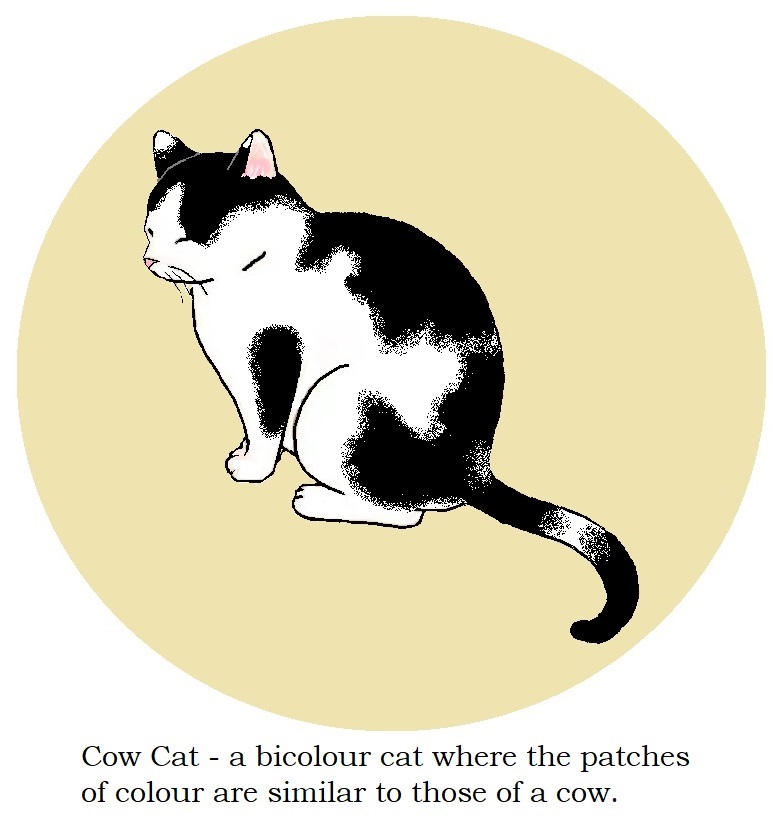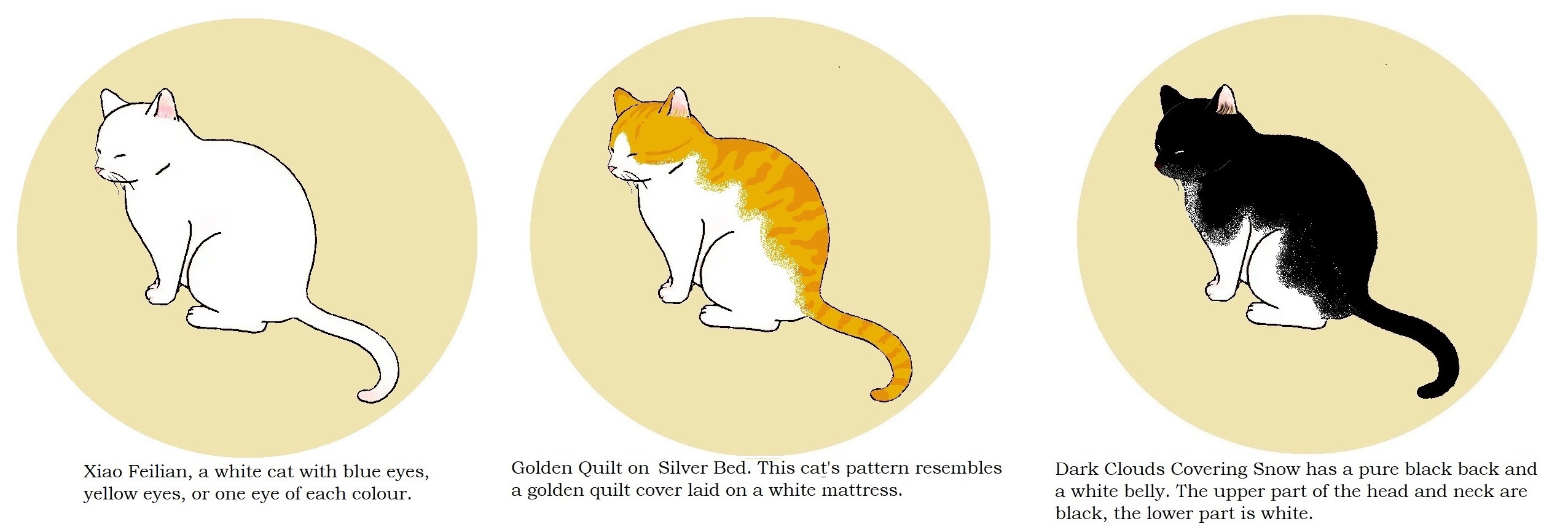
THE CHINESE CAT GARDEN
FOREWORD
A monograph on cats "Mao Cheng" (Cat Garden) was edited by Wang Chutong in the Qing Dynasty. This was a collection of small encyclopedias about cats raised by ancient Chinese people and included the cat's appearance, characteristics and behaviour. It also included the poems and works of famous ancient Chinese masters, and anecdotes and legends about the Civet cat (meaning the native Chinese Mountain Cat, Felis sylvestris bieti, rather than the Palm Civet). There was also "Weng Yun Caotang" by Huang Han, a literati during the Xianfeng period of the Qing Dynasty. It can be said to be China's first book on cats and was divided into 7 sections, including appearance, colour and pattern, spiritual aspects, famous people's cats, and tales and legends. It contained a wide range of allusions, fables and legends about cats in the past dynasties of China, some of which came from books that are now lost to us.
I am not a scholar of Chinese and I've pulled together this English version using diverse sources and translation tools. Many of the names allude to concepts familiar in Chinese culture. There are alternative translations of some symbols and some have double meanings. "Garden Cat" is the Chinese name for a random-bred housecat or non-breed cat.
THE CHINESE CAT GARDEN
The ancient Chinese classified cats according to their shape and colour. ‘As regards the colour of their fur, the perfect yellow ones are called "golden cats." The second place is for the perfectly white ones, called "snow cats". The Cantonese do not like this kind. They call it instead "the cat of filial piety" and consider it a negative omen. After this come the perfectly black cats, called "iron cats". Those with a perfectly homogeneous colour are called "excellent in all four seasons". The yellow-brown-black cats are called "golden brown". The yellow-white-black ones are called "turtle shell spotted". And those with a black back and with white legs and belly are referred to as "black cloud covering the snow".'

JADE RULER (FOOT-LONG JADE), XIAO FEILIAN
The whole body is white, the eyes are both blue, both yellow, or one is blue and the other is yellow. The most prized form is known as "Mandarin Duck-eyes" and has one yellow eye and one blue eye. It is also known as White Snow Cat and Flying White Silk at Night,". It is the descendent of Persian cats, traded along the Silk Roads, crossed with native cats of Luxi. Its history goes back five to six hundred years. The Xiao Feilian has a longer ruff around the neck. Its fur is most precious.
GOLDEN QUILT ON SILVER BED
This cat has a pure golden back, with white belly, white legs and white paws. The name alludes to a golden quilt cover laid on a white mattress.
DARK CLOUDS COVERING SNOW
The back is pure black, the belly is white, and the upper part of the head and neck are black, the lower part being white. In the "Xiang Mao Jing", it is said: "In the variegated colours, the best is dark clouds covering snow." Its blue eyes were crystal clear, and its yellow eyes glittered with gold, clear and transparent.
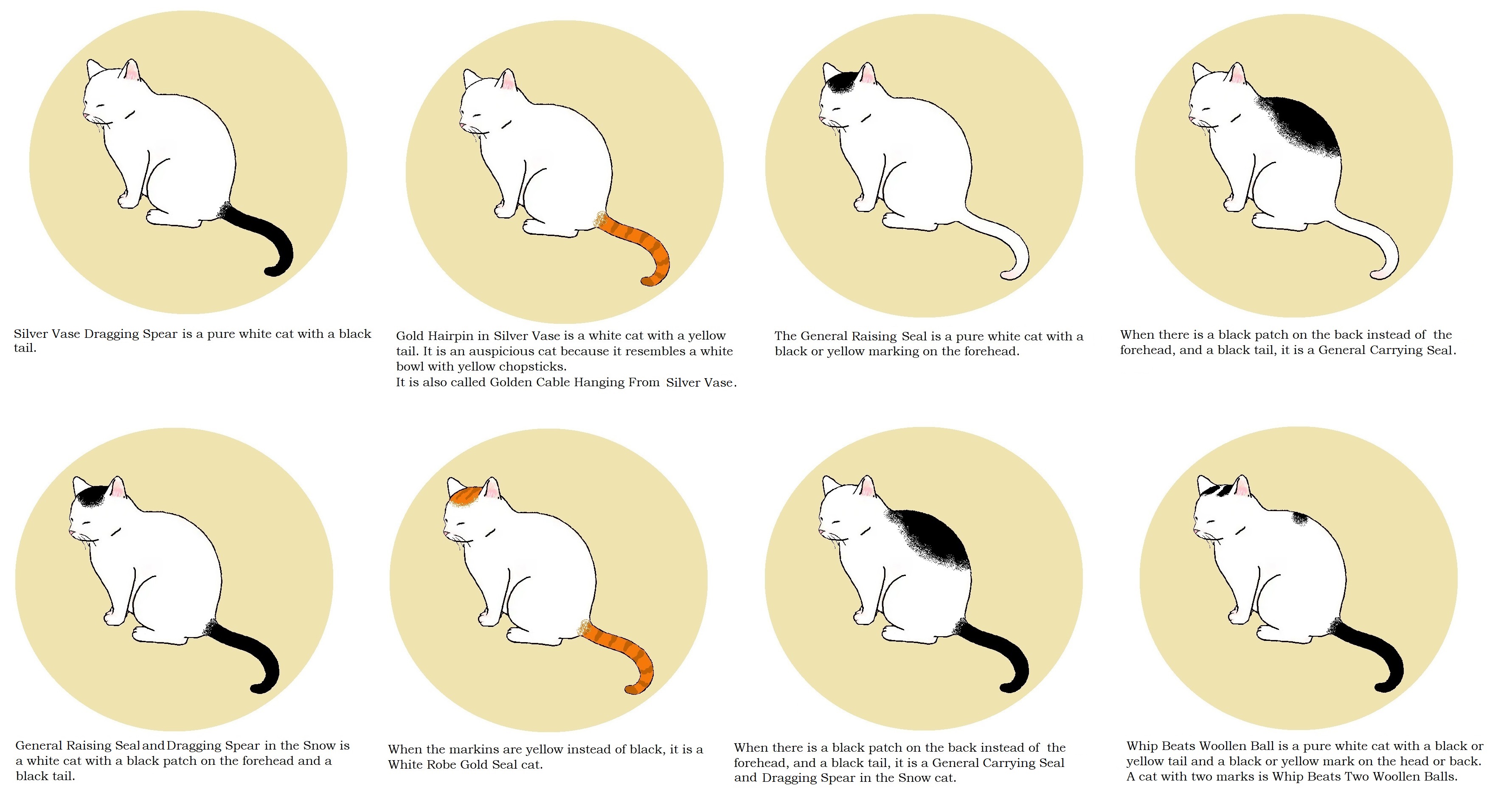
SILVER Vase DRAGGING SPEAR
This cat has a solid white body with a black tail. It is named for the black tail which is the dragging spear. It is also known as Setting Charcoal in the Snow. It is considered a courageous animal and in ancient times, this variety was the favourite cat of many dignitaries and great households.
GOLDEN CABLE HANGING FROM SILVER Vase
The body is white except for the yellow tail which gives this cat its name. According to Zhu Jishan, "There is a pure white cat in the Taiping Market in Yangjiang County, with a yellow tail." It is commonly called 'Golden Cable Hanging from Silver Vase.' "Vase" may also be translated as "Vase."
GENERAL RAISING SEAL AND GENERAL CARRYING SEAL
The whole body is either white or black. A white cat may have a black or yellow marking on the back. This is the General Carrying Seal. A black cat may have a yellow marking. If the marking is on the top of the head, this is the General Raising Seal.
WHIP BEATS WOOLLEN BALL AND WHIP BEATS TWO WOOLLEN BALLS
This is a pure white cat with a black or yellow tail and a black or yellow mark on the head or back. Also called Whip the Silk Ball because the tail is the whip and the marking on the head is the silk ball. A cat with two marks is called "Whip Beats Two Woollen Balls."
The Whip Beats Woollen Ball cat and the Dragging Spear cat partially overlap, it may be called by one name in the North and the other in the South.
GENERAL RAISING SEAL DRAGGING A SPEAR IN THE SNOW
This cat is pure white with a black tail and a black patch on the forehead. The black patch on the forehead is the General Raising Seal. The black tail is the Dragging Spear (or dragging Weapon). It is also known as the Printed Star Cat. A seal was a necessity for ancient civil servants, and military officers carried weapons, so the phrase "dragging the spear and raising the seal" meant "both civil and military". It is also called "Setting Charcoal in the Snow", and "Silver Vase Dragging a Spear" and this colour is considered the most auspicious.
WHITE ROBE, GOLD SEAL
If the markings are yellow instead of black, the pattern is still called "General Raising Seal," but now it is a "White Robe Gold Seal".
GOLD HAIRPIN IN SILVER VASE, GOLDEN CABLE HANGING FROM SILVER VASE
This rare cat belongs to the same category as "Dragging a Spear in the Snow" and "Moli Hidden Needle." The body is white except for the yellow tail which gives this cat its name. It is also "Golden Cable Hanging from Silver Vase." According to Zhu Jishan, "There is a pure white cat in the Taiping Market in Yangjiang County, with a yellow tail." It is commonly called 'Golden Cable Hanging from Silver Vase.'
GENERAL CARRYING SEAL DRAGGING SPEAR IN THE SNOW
This cat has a pure white body, black tail and black patches on the back; there is no patch on the forehead. The black patch on the back is the General Carrying Seal. It has a flexible temperament and is quite fat.
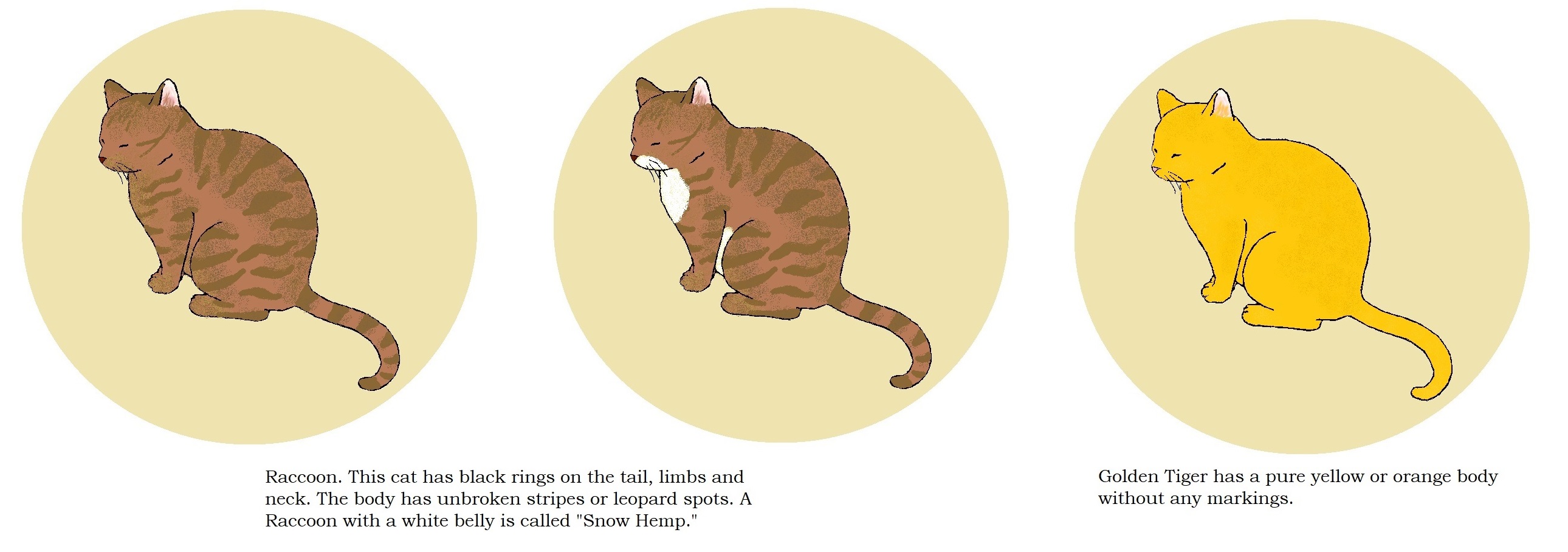
RACCOON PATTERN
This cat has short hair with markings known as tanuki markings. The neck, limbs and tail have black rings while the body has unbroken mackerel stripes or leopard spots. A Raccoon with a white belly is called "Snowy Hemp." One with a broken mackerel pattern is called "Bamboo Shoots." One with the pattern covering the whole body is known as "Wrapped Around." The olive brown variety is called "Green Hemp".
GOLDEN TIGER
This cat has a pure yellow or orange body without any pattern. According to Xiang Maojing, "The pure yellow is called the Golden Tiger, the Golden Bell, The Big Drop of Gold."
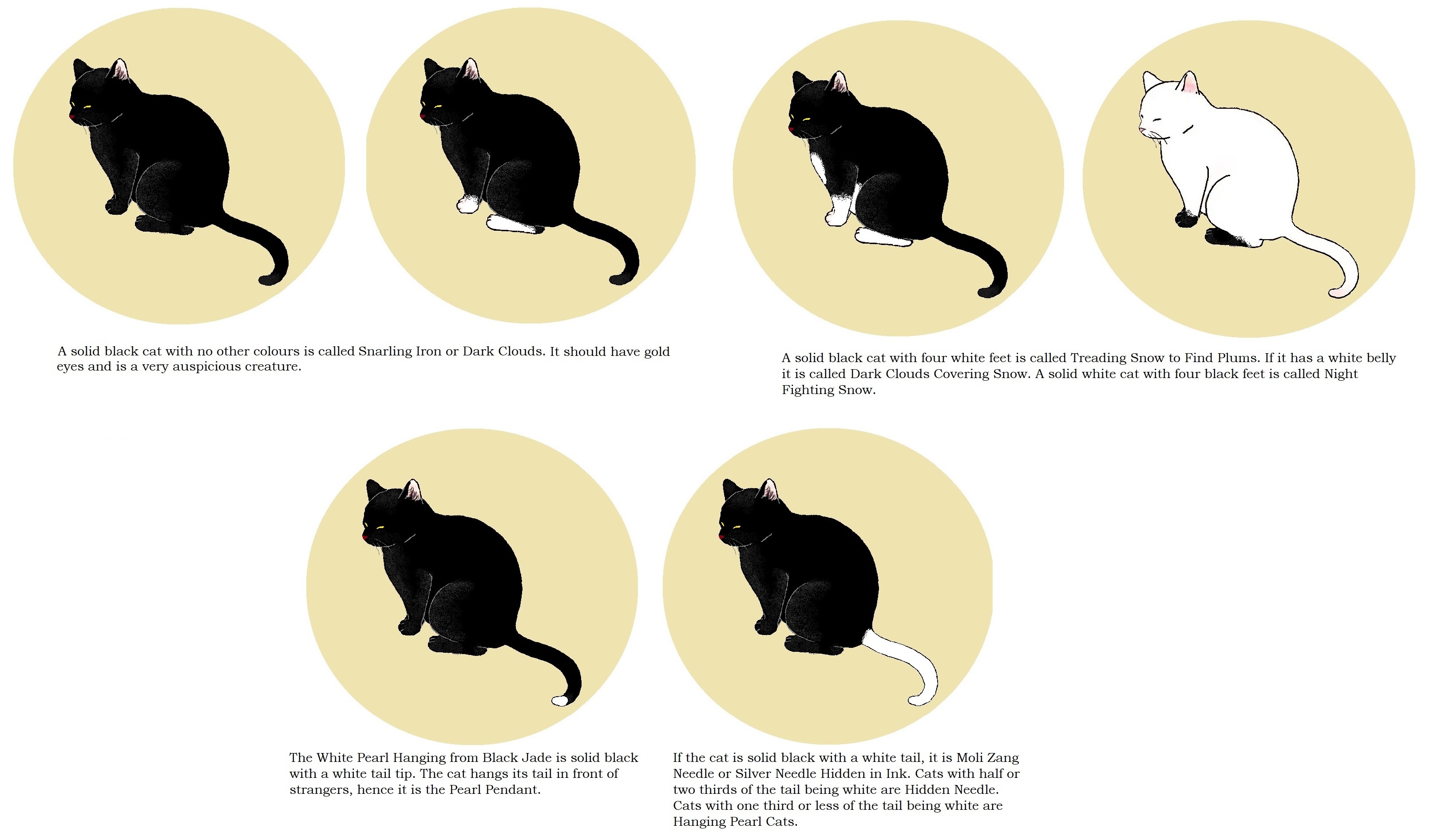
SNARLING IRON / DARK CLOUDS
This cat is solid black without any hairs of other colours. The whiskers and eyebrows are black and the favoured eye colour is gold. In According to Xianmao Jing, any solid colour, whether yellow, white or black, is called "Four Seasons Good". Black cats are very auspicious town house cats in the East. Ancient people believed that black cats could ward off evil, scare away demons and devils, and bring good luck to their owners. In early times, rich people often kept black cats.
TREADING SNOW TO FIND PLUMS
This cat is wholly black except for all four feet, which are pure white, or is pure yellow with white paws. It is also known as the Snow Drill, or Four Hoofs Stepping On The Snow. If it has a white belly, white legs and white claws it is called Dark Clouds Covering Snow. If the whole body is white, and only the four feet are black, it is called " Night Fighting Snow".
WHITE PEARL HANGING FROM BLACK JADE
The whole body is black, and there is a little white tail-tip which is the white pearl hanging from black jade. The cat hangs its tail in front of strangers hence it is a Hanging Pearl, or Pearl Pendant.
MOLI ZANG NEEDLE, SILVER NEEDLE HIDDEN IN INK
This cat has a black body with a white tail. The whole body is black, only the tail is white. It is called the Moli Zang Needle, meaning a silver needle hidden in a block or vase of ink. Hanging Pearl cats and Hidden Needle cats are rare and are considered precious treasures. Generally, the tail is divided into half or thirds; those with more than half of the tail coloured white are Hidden Needles, those with less than half of the tail coloured white are Hanging Pearl cats.
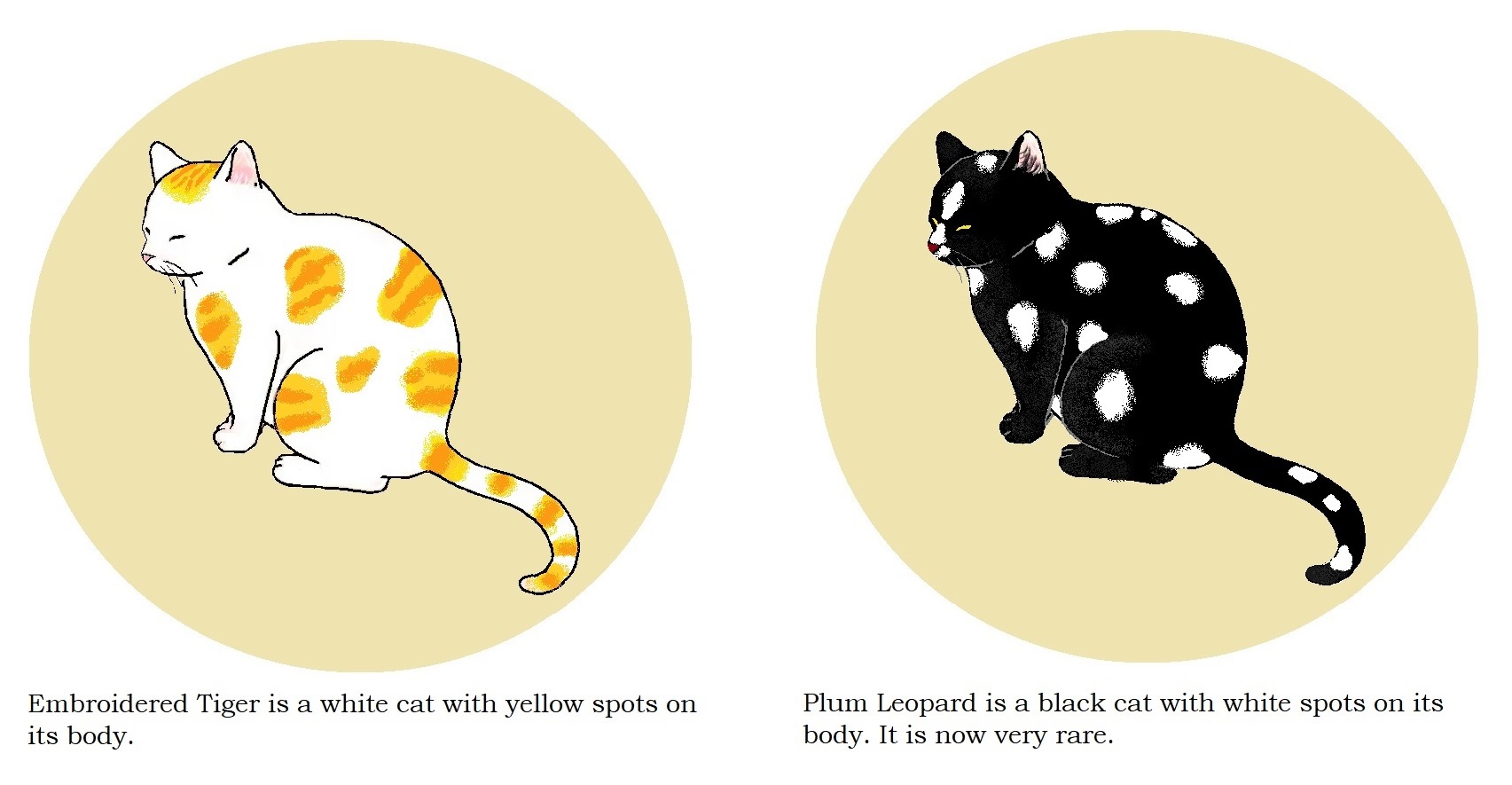
EMBROIDERED TIGER
The "Embroidered Tiger" is a white cat with yellow spots on its body. "Embroidered Tiger" is also called "Snowy Jinluo" or "Snow Gold Engraving". Black cats with white spots all over the body are called "Plum Leopards", also known as "Money Plums," and these are very rare nowadays.
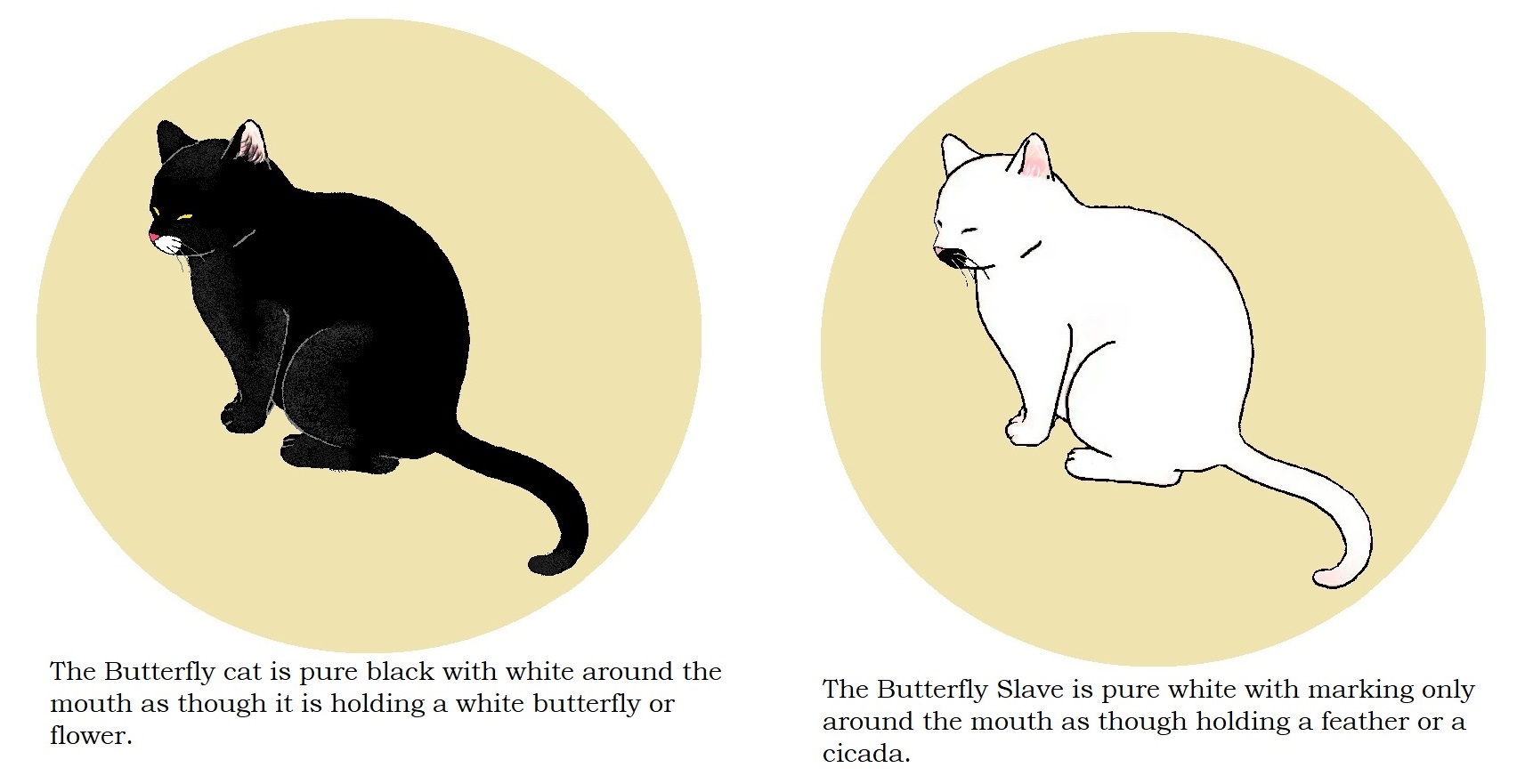
BUTTERFLY AND BUTTERFLY SLAVE
"Butterfly" refers to a black cat with a white mouth as though carrying a white butterfly. You can still see it occasionally, but "Butterfly Slave" is not common anymore. "Butterfly Slave" is a cat whose whole body is white and only has a pattern on the mouth. Pure-coloured cats have different patterns on their mouths, which can "hold" many different things according to the patterns. For example, if the body is pure white and there is a black feather between the upper and lower lips when the lips are closed then this is the "Cicada." The body's solid colour can be pure yellow, pure black, pure white, pure raccoon, etc. Huang Xiangtie's servant tells us that Princess Qionghua of the Later Tang Dynasty raised two cats when she was a child, the white one held a flower in its mouth and was called the Slave of the Butterfly.

GUN DIJIN, ROLLING ON BROCADE
Among tortoiseshell cats, there is the "Gun Dijin" where the colours are spread all over the body. It is said that the low-grade tortoiseshell cats have almost no white on their bodies, showing only yellow and black spots, and most of them are long-haired cats. Some cats have a little white on their bodies, but they have long hair which is difficult to cover the white with yellow and black. If the colours are seen clearly, the cat is a "Gun Dijin".
HOU CAIXIA
Hou Caixia is the whitened version of "Gun Dijin." It is white all over, with black and yellow hair on the back and head only.
THREE-FLOWERED CAT
The "Three Flower Cat" is a three-color cat, with a white body and spots of yellow and black. The Three Flower Cat is defined in the "Xiang Cat Jing" as "a three-colour cat with a yellow, white and black cover". It is classified into top grade, middle grade and low grade according to the form of spots. It has a high probability of having a yin and yang face, with one side yellow and the other black, and with different colour eyes.
WHIP BEATS CHERRIES
This is a white cat with tortoiseshell spots on the head and back.
SHEN CHENLIN'S ALBUM OF CATS
The late Qing court painter Shen Chenlin (working between 1850 and 1870) composed a twelve-page album of cats.
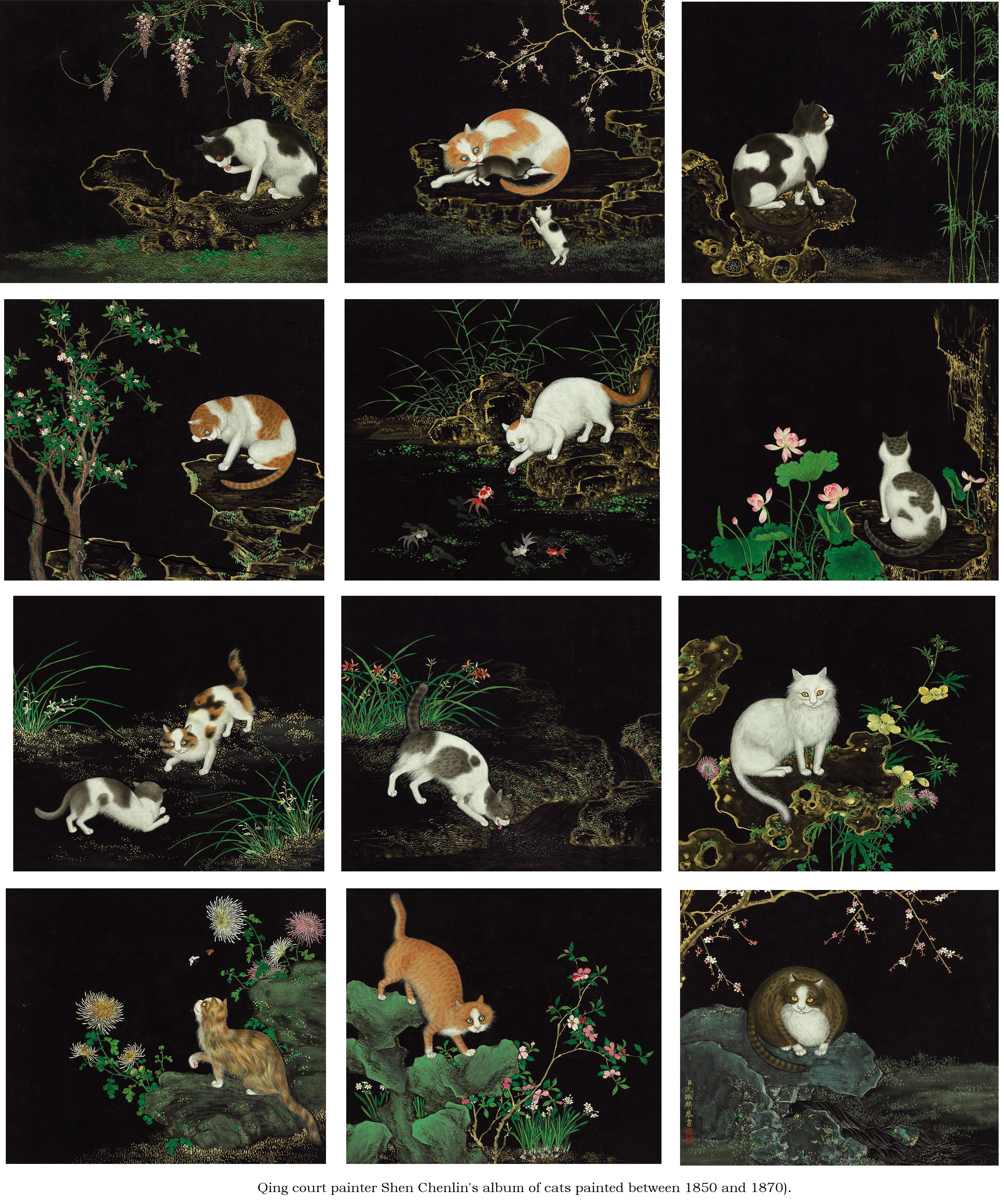
MODERN CHINESE CAT BREEDS
Chinese Garden Cat is a collective term for domestic cats in China, including tabby cat, orange cat (yellow raccoon), Sichuan Jianzhou cat (four-eared cat), Sanhua cat, white cat, black cat (black cat), Shandong lion cat, etc. In China, many consider the Civet to be a type of cat and it can also be kept as a pet. The native wildcat, Felis sylvestris bieti, is also sometimes referred to as the civet. Like the subspecies in Egypt, it became domesticated. Studies have shown cats were domesticated in China over 5,000 years ago. Cats from Persia and Turkey were also traded along the Silk Road.
In China, cats and dogs have both been bred to resemble lions. Though not native to China, the lion is an auspicious animal. Central Asian states present lions to the Chinese emperor in Han capital as a tribute. Lions entered popular Chinese imagination with the spread of Buddhism from India.
SHANDONG LION CAT
Also known as: Linqing Lion Cat, Chinese Big White Cat,
This is mainly found in solid white, although yellow, brown or black-and-white bicolours are also found. The hair on neck and back has a length of up to 4-5 cm. They look like a lion when standing. There are two versions of its origins. One is that it is a descendant of the Turkish Angora cat and originated in the Xinjiang region where cats were traded along the historic Silk Road that ran through the region from the east to its north-western border. The other is that it originated in Linqing City of Shandong Province by crossing Persian cats with local Chinese cats. In ancient Shandong, pets were raised in the court. The "Long-haired Lion Cat" from Linqing is the most famous and precious variety.
The Lion Cat and the Persian cat are both favourite pets in China, valued for their high quality looks and their temperament. The Lion Cat is quite similar to the Persian cat but does not have such a cobby body, short face or snub nose as the latter. It has long, silky, soft fur, a large head, round eyes, pointed ears, long legs, thick body and a thick tail. The fur is longest on the neck, resembling a lion's mane. Its blue eyes are crystal clear, and its yellow eyes glitter with gold, clear and transparent. Apart from its long, thick, snow-white fur, the Lion Cat should preferably have "mandarin duck eyes" (also known as "Yin Yang eyes" or "Gold and Silver eyes"), one being yellow and the other being blue. It has a gentle temperament. The Lion Cat is robust body, has good resistance to disease and is hardy in cold temperatures. It is an expert ratter.
The classification of Shandong Lion Cats is mainly based on coat color. It can be roughly divided into the following four types:
- The White Lion Cat, or Great White Cat, which has a pure white coat and has large, bright blue eyes, yellow eyes, or odd eyes. Some have blue-green eyes or one blue and one green eye. Mandarin duck eyes are the most prized.
- The Black Lion Cat, which has a body slightly longer that the White Lion Cat, its eyes are yellow, its body is white except for its shoulders, and its belly is grey. Black cats are considered good luck animals.
- The Whip Beats Woollen Ball Lion Cat, which has the shape of the White Lion Cat and is white except for black spots on the forehead, and a black tail. The tail is long and pointed and can be thrown towards the head, so it is called "Whipped Hydrangea".
- The Huashi Cat, where some of the back fur is greyish-brown with tabby markings; some have black and yellow spots between the white. According to cat owners, this breed is a descendant of the White Lion Cat crossed with ordinary cats.
DRAGON-LI, TIGER CAT, LI HUA
This variety was recognized by the developing Chinese cat fancy and, for a while, by the CFA in the USA. However, it transpired that two catteries in China used the CFA for marketing their designer breed; the CFA withdrew recognition because the catteries involved had no intention of allowing the cats to be exported. The story behind the "breed" was that tabby cats can be seen everywhere in China, but most are very nondescript and are not Dragon-Li cats. Purebred Dragon-Li were said to be very rare and not found outside of China. Tabby cats are found especially in Shaanxi and Henan provinces. The purported Dragon Li was allegedly developed from a native variety known as the Fox Flower Cat and was claimed to be the descendant of the native Chinese Mountain Cat, rather than the African Wildcat. Although this a controversial, the two subspecies are closely related and can interbreed so it has not been disproved. The Dragon-Li was described as similar to a tabby American Shorthair. Its neck and abdomen are covered with greyish fur. The fur colour of other parts of the body gradually transitions from blackish-grey into regular stripes, just like that of tigers, from which its name originates. It has short, glossy fur. Although it is an expert ratter, it is not as robust as the Lion Cat.
CHINESE TANK SHORTHAIR/LONGHAIR
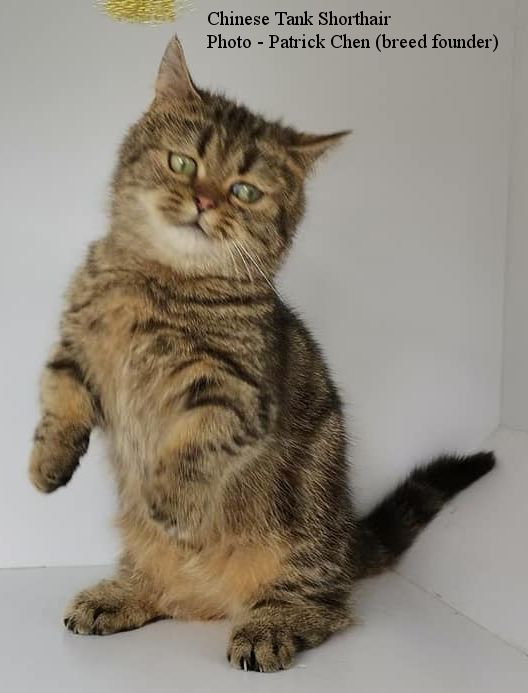
The Chinese Tank (CTS) and the Chinese Tank Longhair (CTL) are short-legged cats with a round face with a sweet, open expression. The breed was founded in China by Jackson Chen and is recognised by International Cat Union, the largest registry of purebred and outbred cats and kittens in Russia and has a presence in China.
The Chinese Tank is medium to large in size with a muscular, somewhat cobby conformation. Its head is massive, broad and round with well-rounded contours and well-developed full cheeks, wide space between the ears and a rounded forehead. The wide-set ears are medium- to small-sized, broad at the base, round-tipped, and tilted slightly forward. The eyes are large, round and well-open, set one eye’s width apart, Eye colour corresponds to the coat colour. The well-developed chin is strong, broad and deep and forms a line with the nose leather. The muzzle is short and rounded with well-developed, wide whiskers pads that transition smoothly towards the cheekbones. The nose is short and broad. There is a change of angle between the rounded forehead and the short, straight nose, but this must not be extreme. The neck is short, broad and muscular.
It has a broad, strong, muscular torso, rounded with a wide chest. Its back is straight, medium to short in length (short is preferable), and equally broad along its length from the shoulders to the hips. Females are proportionally smaller than males. Its legs are short and sturdy. The back legs are slightly longer than the front legs, but are angled so that the back is level. The paws are large and round. The tail is thick at the base, straight, and tapers slightly to a rounded tip. Tail length is equal to two-thirds the length of the body.
The fur of the Chinese Tank Shorthair is plushy, firm and thick with a dense undercoat. The Chinese Tank Longhair has a semi-long coat with the fur standing away from the body, and preferably with a ruff and britches; texture is fluffy and dense with a dense undercoat. The coat density and texture may differ with season changes. Blue-coated cats seem to have slightly harder textured coats than other colours. All colours are permitted, but white lockets are not acceptable.
The short legs do not affect mobility; these cats are active, owner-focussed and enjoy communicating with people. They can be outcrossed to the British Shorthair/Longhair and the Minuet breed. In terms of the global cat fancy, their short legs and Minuet ancestry make them part of the Munchkin breed group.
CLOUDED CAT (PALM CIVET)
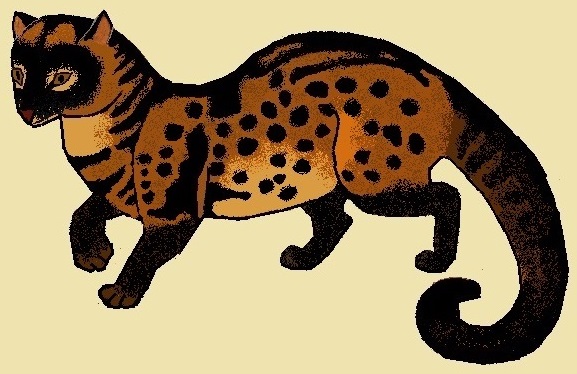
The Clouded Cat gets its name from having stripes in the shape of cloud. It is not a true cat but is the Palm Civet. It is generally brownish yellow or blackish-grey all over, with black head and brownish-black limbs and tail. It has white spots on the side and underside of the eyes, black dapples on both sides of the body, and several longitudinal black stripes on the back. Its pretty appearance makes it a precious ornamental "cat" variety. On average, it gives birth twice a year, with 2 to 4 young each time. It is only found in southern China.
SICHUAN JIANZHOU CAT
This cat has a large, robust physique. It is fast and it is an excellent rat-catcher. It comes from today's Janyang, a city located between Chengdu and Chongqing. Sichuan Jianzhou cats are reputedly expert hunters and are raised in large numbers in the countryside. They are mainly kept for catching rats. In Janyang, Sichuan, the local people use Jianzhou cats as "sacred cats" to stop rats. Cats in Jianzhou have different fur colors, mostly mixed fur. The notch at the base of their ears is more pronounced than in other cats and they look as if they have four ears, hence its other name Four-Eared Cat.
CHINESE GARDEN CAT (COMMON DOMESTIC CAT)
There are also many types of Chinese garden cats and these are classified by colour and pattern. Here are some of the names unfamiliar to Westerners, and not in the list of historical varieties:
- Sanhua cat, Three-Flowered Cat - this is the tortoiseshell and white variety and is very common.
- Cow Cat – this is a bicolour cat where the patches are similar to those of a cow, it is reputedly a very naughty cat that must be properly trained from young.
- Civet Cat – a tabby cat, the name alludes to the civet-like stripped and spotted markings.
- Yellow Civet Cat – the yellow or orange form of tabby cat.
